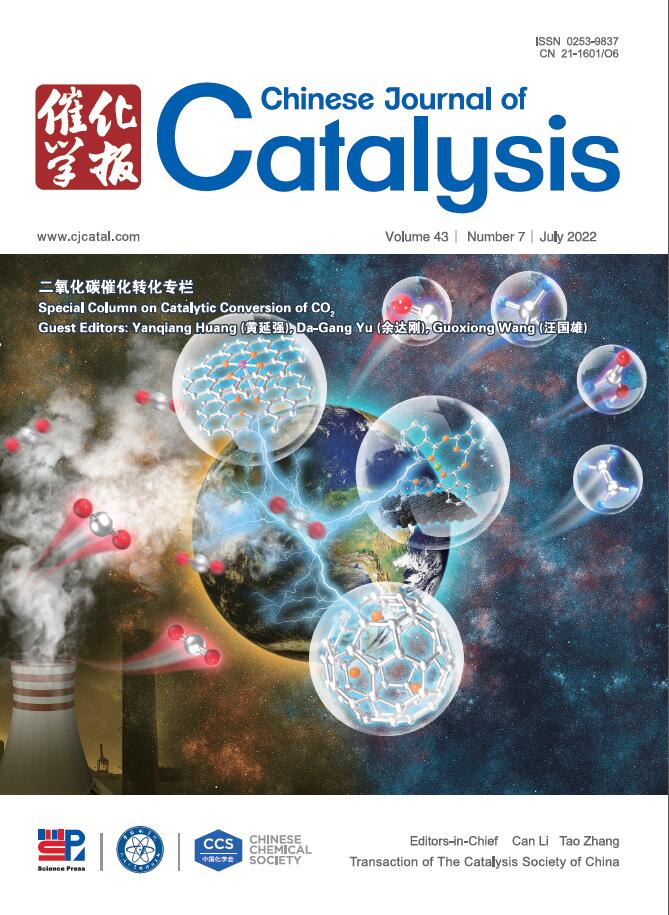Electrochemistry assisted chlorine corrosion strategy: The minute-level fabrication of lattice Cl– functioned high spin-polarized Ni/Fe-LDH array for enhanced anti-Cl– OER performance
IF 15.7
1区 化学
Q1 CHEMISTRY, APPLIED
引用次数: 0
Abstract
Although the intermittent energy-driven direct seawater splitting technology provides an unparalleled approach to achieving sustainable development, the severe corrosion via aggressive Cl– severely affects the stability and efficiency of the anode catalyst and limits its industrial application. Herein, a lattice Cl– functioned NiFe-LDH electrode (E-NF-LDHCl or E-NF-LDHSW) is firstly constructed by a minute-level electrochemistry assisted chlorine corrosion strategy, which presents enhanced oxygen evolution reaction (OER) performance and excellent anti-Cl– corrosion behavior for seawater splitting. The optimized E-NF-LDHCl and E-NF-LDHSW deliver low OER overpotential of 355 and 384 mV to reach 1 A cm−2 current density in the 1 mol L–1 KOH and 1 mol L–1 KOH seawater, respectively, as well as excellent stability of E-NF-LDHCl is maintained at 1 A cm–2 for 400 h in the 1 mol L–1 KOH and 1 mol L–1 KOH + 0.5 mol L–1 NaCl. MD (molecular dynamics) simulation and DFT (density functional theory) calculation confirmed that strong common-ion repulsion effect in IHP region repels free Cl–, forming high spin polarization centers and more single electrons to enhance the intrinsic activity of OER.
电化学辅助氯腐蚀策略:用于增强抗Cl - OER性能的晶格Cl功能高自旋极化Ni/Fe-LDH阵列的分钟级制造
虽然间歇式能量驱动的直接海水裂解技术为实现可持续发展提供了无与伦比的途径,但腐蚀性Cl -的严重腐蚀严重影响了阳极催化剂的稳定性和效率,限制了其工业应用。本文首次采用微量电化学辅助氯腐蚀策略构建了晶格型Cl -功能NiFe-LDH电极(E-NF-LDHCl或E-NF-LDHSW),该电极具有增强的析氧反应(OER)性能和优异的抗Cl腐蚀性能,可用于海水分裂。优化后的E-NF-LDHCl和E-NF-LDHSW在1 mol L-1 KOH和1 mol L-1 KOH海水中OER过电位分别为355和384 mV,电流密度达到1 A cm - 2,并且E-NF-LDHCl在1 mol L-1 KOH和1 mol L-1 KOH + 0.5 mol L-1 NaCl中保持1 A cm - 2 400 h的优异稳定性。MD(分子动力学)模拟和DFT(密度泛函理论)计算证实了IHP区强的共离子排斥效应排斥自由Cl -,形成高自旋极化中心和更多的单电子,增强OER的本征活性。
本文章由计算机程序翻译,如有差异,请以英文原文为准。
求助全文
约1分钟内获得全文
求助全文
来源期刊

Chinese Journal of Catalysis
工程技术-工程:化工
CiteScore
25.80
自引率
10.30%
发文量
235
审稿时长
1.2 months
期刊介绍:
The journal covers a broad scope, encompassing new trends in catalysis for applications in energy production, environmental protection, and the preparation of materials, petroleum chemicals, and fine chemicals. It explores the scientific foundation for preparing and activating catalysts of commercial interest, emphasizing representative models.The focus includes spectroscopic methods for structural characterization, especially in situ techniques, as well as new theoretical methods with practical impact in catalysis and catalytic reactions.The journal delves into the relationship between homogeneous and heterogeneous catalysis and includes theoretical studies on the structure and reactivity of catalysts.Additionally, contributions on photocatalysis, biocatalysis, surface science, and catalysis-related chemical kinetics are welcomed.
 求助内容:
求助内容: 应助结果提醒方式:
应助结果提醒方式:


